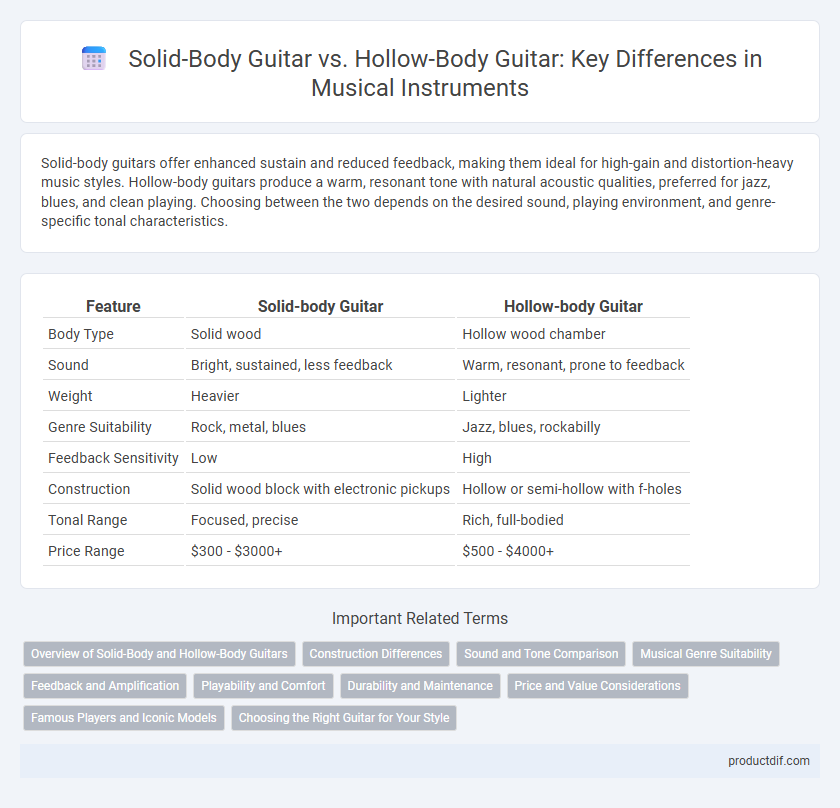Solid-body guitars offer enhanced sustain and reduced feedback, making them ideal for high-gain and distortion-heavy music styles. Hollow-body guitars produce a warm, resonant tone with natural acoustic qualities, preferred for jazz, blues, and clean playing. Choosing between the two depends on the desired sound, playing environment, and genre-specific tonal characteristics.
Table of Comparison
| Feature | Solid-body Guitar | Hollow-body Guitar |
|---|---|---|
| Body Type | Solid wood | Hollow wood chamber |
| Sound | Bright, sustained, less feedback | Warm, resonant, prone to feedback |
| Weight | Heavier | Lighter |
| Genre Suitability | Rock, metal, blues | Jazz, blues, rockabilly |
| Feedback Sensitivity | Low | High |
| Construction | Solid wood block with electronic pickups | Hollow or semi-hollow with f-holes |
| Tonal Range | Focused, precise | Rich, full-bodied |
| Price Range | $300 - $3000+ | $500 - $4000+ |
Overview of Solid-Body and Hollow-Body Guitars
Solid-body guitars feature a solid wood construction that significantly reduces feedback and allows for higher gain and sustain, making them ideal for genres like rock and metal. Hollow-body guitars, with their larger, resonant chambers, provide a warm, rich tone favored in jazz and blues but are more prone to feedback at high volumes. The choice between solid and hollow bodies depends on the player's tonal preference and performance environment, with solid bodies offering durability and versatility while hollow bodies emphasize acoustic resonance and classic sound.
Construction Differences
Solid-body guitars feature a dense, solid wooden core that enhances sustain and reduces feedback, making them ideal for high-gain amplification. Hollow-body guitars contain a resonant, enclosed chamber similar to an acoustic guitar, which produces warm, rich tones but is more prone to feedback at high volumes. The construction differences significantly impact sound projection, tonal characteristics, and suitability for various musical styles.
Sound and Tone Comparison
Solid-body guitars deliver a focused, sustained sound with reduced feedback, making them ideal for high-gain and rock genres. Hollow-body guitars produce a warmer, resonant tone with natural acoustic qualities, favored in jazz and blues for their rich harmonic complexity. The tonal difference arises from solid versus hollow construction, impacting resonance, feedback susceptibility, and sound projection.
Musical Genre Suitability
Solid-body guitars excel in genres like rock, metal, and punk due to their resistance to feedback and ability to handle high-gain amplification, delivering a powerful, sustained tone. Hollow-body guitars suit jazz, blues, and rockabilly by producing warm, resonant sounds with natural acoustic qualities and enhanced tonal depth. Musicians select solid-body guitars for aggressive styles and hollow-body guitars for genres emphasizing rich, mellow tones and dynamic articulation.
Feedback and Amplification
Solid-body guitars produce less feedback at high volumes due to their dense construction, making them ideal for amplified performances and distortion-heavy genres. Hollow-body guitars, with their resonant chambers, are more prone to feedback but offer rich, warm tones favored in jazz and blues. Amplifiers and effects pedals can be adjusted to manage feedback in hollow-body guitars while preserving their natural acoustic qualities.
Playability and Comfort
Solid-body guitars offer enhanced playability and comfort with their lighter weight and thinner neck profiles, making them ideal for extended performances and fast playing styles. Hollow-body guitars, while heavier and bulkier, provide a fuller, resonant tone but may require more effort to handle due to their larger body size and depth. Jazz and blues musicians often prefer hollow-body guitars despite the trade-off in comfort because of their rich sound characteristics.
Durability and Maintenance
Solid-body guitars offer superior durability due to their dense wooden construction, making them less susceptible to damage from environmental changes and physical impacts. Hollow-body guitars require more careful maintenance because their hollow chambers are vulnerable to humidity fluctuations and cracks, demanding regular humidity control and delicate handling. The solid-body design minimizes feedback issues and reduces the need for frequent repairs, providing a more robust option for rigorous use.
Price and Value Considerations
Solid-body guitars generally offer more affordable price points and greater durability, making them ideal for beginners and gigging musicians seeking long-term value. Hollow-body guitars, while often more expensive due to their craftsmanship and rich acoustic tone, are prized in jazz and blues for their unique sound quality, reflecting a higher investment for specialized performance. Evaluating price against personal musical style and usage frequency ensures the best value choice between solid and hollow-body guitars.
Famous Players and Iconic Models
Solid-body guitars like the Fender Stratocaster, famously used by Jimi Hendrix and Eric Clapton, offer durability and high gain suitable for rock and blues. Hollow-body guitars, exemplified by the Gibson ES-335, gained iconic status through players like B.B. King and Chuck Berry, known for their warm, resonant tone perfect for jazz and early rock. These legendary instruments remain benchmarks in their genres, influencing countless musicians and guitar designs.
Choosing the Right Guitar for Your Style
Solid-body guitars offer increased sustain and reduced feedback, making them ideal for rock, metal, and high-gain playing styles. Hollow-body guitars provide warm, resonant tones favored in jazz, blues, and vintage rock, but can be prone to feedback at high volumes. Selecting the right guitar depends on the genre, desired tone, and playing environment to maximize sonic performance.
Solid-body guitar vs Hollow-body guitar Infographic

 productdif.com
productdif.com